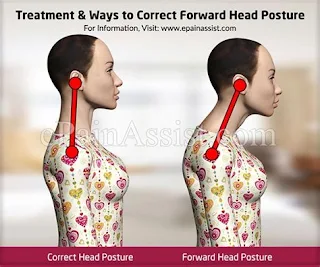The Forward Head Posture: Three Ways to Improve It
It's likely that you have forward head posture if your neck curves inward and your head rests in front of your shoulders rather than squarely on top of them. This posture is also known as a forward chin posture. This position can cause your neck muscles to become fatigued, and it can add the equivalent of dozens of extra pounds of pressure to your cervical spine, which can increase the risk of spinal degeneration.
The Relationship Between Poor Posture and Neck Pain
A forward head position can result in a number of health issues, such as increased strain on the cervical spine, muscular overload, and an upper back that is hunched forward. When the forward head posture is maintained for extended periods of time, there is an increased risk of experiencing neck discomfort, stiffness, and other symptoms. Read about how bad posture can cause neck pain here.
If you make these straightforward routines a part of your daily routine, you'll be able to assist improve forward head posture over time.
Chin tucks and chest stretches should be performed first thing in the morning.
A chin tuck is a simple and efficient exercise that can help develop your upper thoracic extensors, which are the muscles responsible for keeping your head in proper alignment with your shoulders.
One of the primary exercises that is suggested to assist in maintaining a position of the head that is aligned above the spine is the chin tuck.
• Lean your upper back against a wall while standing with your feet about shoulder-width apart.
• Turn your body so that you are facing front, tuck your chin in, and bring your head back until it is flush against the wall.
•
Repeat this stretch 10 times while holding it for 5 seconds each time before taking a rest.
Your head may appear to be thrusting forward if the chest muscles in your chest are tight. If you stretch out your major and minor pectoral muscles, it may be simpler for your shoulders and head to maintain a pulled-back position, which is essential for healthy posture.
A deep stretch of the chest and shoulders is provided by the corner stretch, which can contribute to the maintenance of healthy posture. Watch:
• Position yourself so that you are facing a room's corner or a doorway. Put your forearms up against each wall (or each door jamb), and position your elbows so that they are just slightly below the height of your shoulders.
•
Lean forward until you feel a stretch in the chest directly under the collarbone.
• Maintain this position for up to one minute.
Make some room in your morning routine for these stretches. A modest investment of two minutes at the beginning of each day may offer enormous returns for your posture. You should make this investment. If any of these exercises are causing pain, stop doing them immediately.
2. Ensure that your workstation is set up in an ergonomic manner.
When you spend the most of your day sitting in a chair and gazing at a computer, it's easy to develop a forward-curving posture in your head and shoulders. Make sure that your workspace is set up in such a way that it encourages you to maintain your head in line with your shoulders at all times.
Adjustments can be made to the position of your desk, computer display, and/or keyboard to assist in maintaining proper alignment of your head and neck.
• Raise the height of your computer display so that when you gaze straight ahead, the top third of the screen is in view when you do so.
• Adjust the placement of your mouse and keyboard so that when you use them, your forearms are perpendicular to the ground and your elbows are bent at an angle of about ninety degrees.
• Invest in a chair for your workplace that comes equipped with a headrest so that you may rest the back of your head on it while you're working.
If you still discover that you are hunching your shoulders and bringing your head forward, you should put a reminder on your phone to check your posture many times during the day.
Use a cervical pillow when you sleep.
The natural curves of the head and cervical spine are better supported by the cervical pillow's characteristic design, which features an inwardly curved centre. This type of cushion is also frequently referred to as an orthopaedic pillow. The design intends for your neck to remain in its natural position rather than being bent forward. You may create a similar effect by lying on your back with a rolled-up towel placed under your neck in place of a pillow. This will allow your spine to be more aligned.
Since there is no conclusive medical data that favours one type of pillow over another, you should base your selection over which pillow to use on your own level of personal comfort.
See Support and relaxation provided by pillows
You won't see immediate results if you try to improve forward head position overnight. Make a commitment to following these pointers, and in the next weeks and months, see whether you can identify any signs of progress. Consult a physical therapist if your forward head posture is extreme or if it causes you discomfort. They will be able to give you with further assistance and choices to help improve your posture.
Do you have discomfort in your upper back, tightness in your shoulders, or stiffness in your neck? Do you suffer from headaches, migraines, or do you have particularly poor posture? It's possible that the problem is as straightforward as keeping your head cocked too far forward. When your head is positioned in an abnormally forward position, this is known as forward head posture.






No comments:
Post a Comment